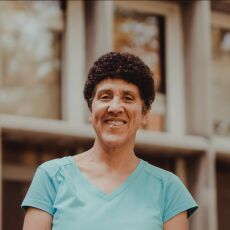Christopher Williams
I think the power of mentorship and mentoring students, especially students in early career, cannot be overstated. It makes a huge impact on people’s lives. Being mentored by Kurt Weiler when I was a radio astronomer as a high schooler cemented my decision going into college.

NASA Astronaut Christopher L. Williams
NASA/Robert Markowitz
Christopher’s story
Growing up, Christopher Williams was enamored by the U.S. space program and dreamed of going to space one day. Funnily enough, by the age of 11, young Christopher didn’t think being an astronaut was a real job that he could have. To him, the chances of becoming one seemed too low, but he knew his calling was in physics and astronomy. Now a NASA astronaut with his first mission scheduled for late 2025, his story is one of passion, hard work, and mentorship.
Space exploration has fascinated Christopher for as long as he can remember — as a kindergartner he found himself drawing pictures of space shuttles while in class. Although his astronaut dreams started at age 5 and he recalls being bitten by the science bug at 11, it was during his teenage years that he truly discovered his love for physics and astronomy. A high school internship focused on radio astronomy at the Naval Research Center made him confident that he was exactly where he was supposed to be. He gives high praise to his mentor during this internship, Dr. Kurt Weiler. Christopher came into the internship as a 10th grader with a fresh set of eyes and a limited amount of knowledge. Weiler guided Christopher as he made contributions to their research, helped him learn and understand the intricate work along the way, and introduced him to the physics and astronomy community that he now belongs to.
His educational journey took him to Stanford University where he earned his bachelor’s in physics in 2005. He later earned his Ph.D. in physics from the Massachusetts Institute of Technology (MIT) in 2012. He is also a board-certified medical physicist who completed his residency at Harvard Medical School.
During a break between his undergraduate and graduate school, he found himself back at Naval Research Lab as well as NASA Goddard Space Flight Center doing radio and x-ray astronomy. While pursuing his Ph.D., he helped build a prototype for a telescope that is now operating in Western Australia. As a medical physicist at Harvard, his research focused on developing a new type of image guidance technique for cancer patients. He has had many incredible moments in his career so far but he says these are two of his proudest achievements.
Driven by passion for physics, his skillset made for an easy transition from astronomer and astrophysicist to medical physicist to now being the flight engineer for Expedition 74. With this being his first mission to the International Space Station aboard a Roscosmos Soyuz MS-28 spacecraft in his near future, Christopher’s story is a true testament that the possibilities for physicists are endless.
Science
As a high schooler, he was a budding astronomer interning at the U.S. Naval Research Laboratory. Christopher was a radio astronomer at the U.S. Naval Research Laboratory. He later worked as an assistant professor at Harvard Medical School and as a medical physicist in the Radiation Oncology Department at the Brigham and Women’s Hospital, Boston and Dana-Farber Institute.
While pursuing his doctorate at MIT, he was part of the team that built the Murchison Widefield Array, which can now be found in Western Australia and is used to study the epoch of reionization of the early universe.
Interests
Christopher is an Eagle Scout and enjoys spending time out in nature and traveling with his loved ones. He and his wife have two young daughters and he considers Potomac, Maryland home.
Growing up, he and his family would get together to watch Star Trek, which helped feed his fascination with space and exploration.
https://www.nasa.gov/humans-in-space/astronauts/nasa-astronaut-christopher-l-williams/




